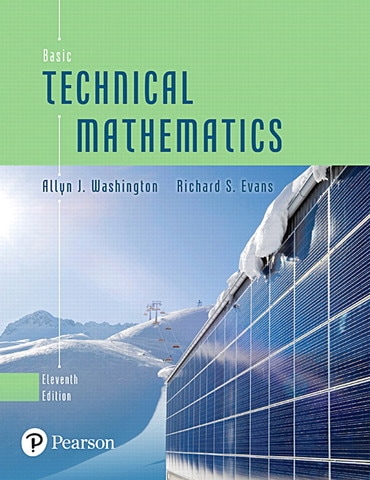
Basic Technical Mathematics, 11th edition
Published by Pearson (February 7, 2017) © 2018
- Allyn J. Washington Dutchess Community College
- Richard Evans Corning Community College
Title overview
Basic Technical Mathematics will unlock your ability to apply math to a vast number of technical and pre-engineering fields. The text will enhance your grasp of algebra and trigonometry to support your success in solving applied problems. Ultimately, you'll develop a firm understanding of mathematical methods.
Table of contents
1 Basic Algebraic Operations
1.1 Numbers
1.2 Fundamental Operations of Algebra
1.3 Calculators and Approximate Numbers
1.4 Exponents and Unit Conversions
1.5 Scientific Notation
1.6 Roots and Radicals
1.7 Addition and Subtraction of Algebraic Expressions
1.8 Multiplication of Algebraic Expressions
1.9 Division of Algebraic Expressions
1.10 Solving Equations
1.11 Formulas and Literal Equations
1.12 Applied Word Problems
2 Geometry
2.1 Lines and Angles
2.2 Triangles
2.3 Quadrilaterals
2.4 Circles
2.5 Measurement of Irregular Areas
2.6 Solid Geometric Figures
3 Functions and Graphs
3.1 Introduction to Functions
3.2 More about Functions
3.3 Rectangular Coordinates
3.4 The Graph of a Function
3.5 Graphs on the Graphing Calculator
3.6 Graphs of Functions Defined by Tables of Data
4 The Trigonometric Functions
4.1 Angles
4.2 Defining the Trigonometric Functions
4.3 Values of the Trigonometric Functions
4.4 The Right Triangle
4.5 Applications of Right Triangles
5 Systems of Linear Equations Determinants
5.1 Linear Equations and Graphs of Linear Functions
5.2 Systems of Equations and Graphical Solutions
5.3 Solving Systems of Two Linear Equations in Two Unknowns Algebraically
5.4 Solving Systems of Two Linear Equations in Two Unknowns by Determinants
5.5 Solving Systems of Three Linear Equations in Three Unknowns Algebraically
5.6 Solving Systems of Three Linear Equations in Three Unknowns by Determinants
6 Factoring and Fractions
6.1 Factoring: Greatest Common Factor and Difference of Squares
6.2 Factoring Trinomials
6.3 The Sum and Difference of Cubes
6.4 Equivalent Fractions
6.5 Multiplication and Division of Fractions
6.6 Addition and Subtraction of Fractions
6.7 Equations Involving Fractions
7 Quadratic Equations
7.1 Quadratic Equations; Solution by Factoring
7.2 Completing the Square
7.3 The Quadratic Formula
7.4 The Graph of the Quadratic Function
8 Trigonometric Functions of Any Angle
8.1 Signs of the Trigonometric Functions
8.2 Trigonometric Functions of Any Angle
8.3 Radians
8.4 Applications of Radian Measure
9 Vectors and Oblique Triangles
9.1 Introduction to Vectors
9.2 Components of Vectors
9.3 Vector Addition by Components
9.4 Applications of Vectors
9.5 Oblique Triangles, the Law of Sines
9.6 The Law of Cosines
10 Graphs of the Trigonometric Functions
10.1 Graphs of y = a sin x and y = a cos x
10.2 Graphs of y = a sin bx and y = a cos bx
10.3 Graphs of y = a sin (bx + c) and y = a cos (bx + c)
10.4 Graphs of y = tan x, y = cot x, y = sec x, y = csc x
10.5 Applications of the Trigonometric Graphs
10.6 Composite Trigonometric Curves
11 Exponents and Radicals
11.1 Simplifying Expressions with Integer Exponents
11.2 Fractional Exponents
11.3 Simplest Radical Form
11.4 Addition and Subtraction of Radicals
11.5 Multiplication and Division of Radicals
12 Complex Numbers
12.1 Basic Definitions
12.2 Basic Operations with Complex Numbers
12.3 Graphical Representation of Complex Numbers
12.4 Polar Form of a Complex Number
12.5 Exponential Form of a Complex Number
12.6 Products, Quotients, Powers, and Roots of Complex Numbers
12.7 An Application to Alternating-current (ac) Circuits
13 Exponential and Logarithmic Functions
13.1 Exponential Functions
13.2 Logarithmic Functions
13.3 Properties of Logarithms
13.4 Logarithms to the Base 10
13.5 Natural Logarithms
13.6 Exponential and Logarithmic Equations
13.7 Graphs on Logarithmic and Semilogarithmic Paper
14 Additional Types of Equations and Systems of Equations
14.1 Graphical Solution of Systems of Equations
14.2 Algebraic Solution of Systems of Equations
14.3 Equations in Quadratic Form
14.4 Equations with Radicals
15 Equations of Higher Degree
15.1 The Remainder and Factor Theorems; Synthetic Division
15.2 The Roots of an Equation
15.3 Rational and Irrational Roots
16 Matrices; Systems of Linear Equations
16.1 Matrices: Definitions and Basic Operations
16.2 Multiplication of Matrices
16.3 Finding the Inverse of a Matrix
16.4 Matrices and Linear Equations
16.5 Gaussian Elimination
16.6 Higher-order Determinants
17 Inequalities
17.1 Properties of Inequalities
17.2 Solving Linear Inequalities
17.3 Solving Nonlinear Inequalities
17.4 Inequalities Involving Absolute Values
17.5 Graphical Solution of Inequalities with Two Variables
17.6 Linear Programming
18 Variation
18.1 Ratio and Proportion
18.2 Variation
19 Sequences and the Binomial Theorem
19.1 Arithmetic Sequences
19.2 Geometric Sequences
19.3 Infinite Geometric Series
19.4 The Binomial Theorem
20 Additional Topics in Trigonometry
20.1 Fundamental Trigonometric Identities
20.2 The Sum and Difference Formulas
20.3 Double-Angle Formulas
20.4 Half-Angle Formulas
20.5 Solving Trigonometric Equations
20.6 The Inverse Trigonometric Functions
21 Plane Analytic Geometry
21.1 Basic Definitions
21.2 The Straight Line
21.3 The Circle
21.4 The Parabola
21.5 The Ellipse
21.6 The Hyperbola
21.7 Translation of Axes
21.8 The Second-degree Equation
21.9 Rotation of Axes
21.10 Polar Coordinates
21.11 Curves in Polar Coordinates
22 Introduction to Statistics
22.1 Graphical Displays of Data
22.2 Measures of Central Tendency
22.3 Standard Deviation
22.4 Normal Distributions
22.5 Statistical Process Control
22.6 Linear Regression
22.7 Nonlinear Regression
Appendix A Solving Word Problems
Appendix B Units of Measurement